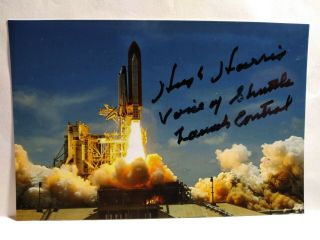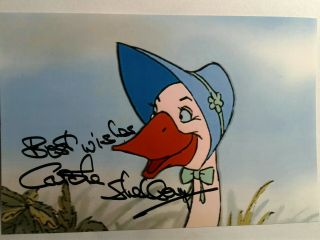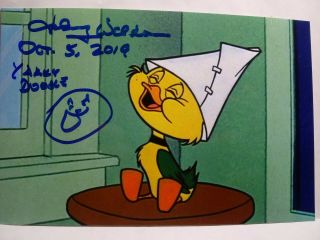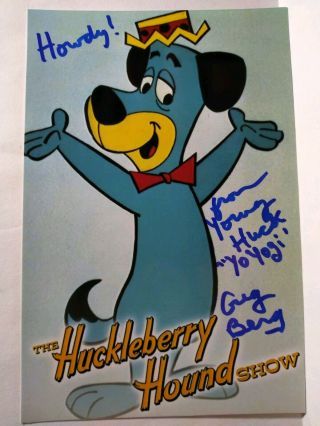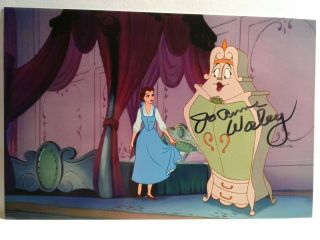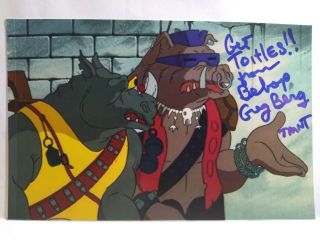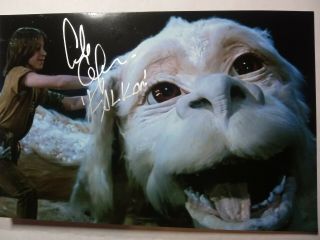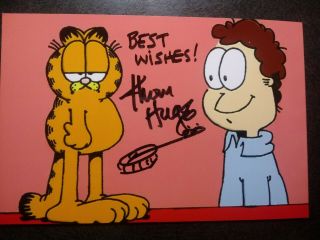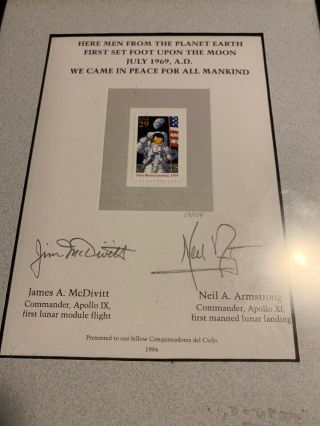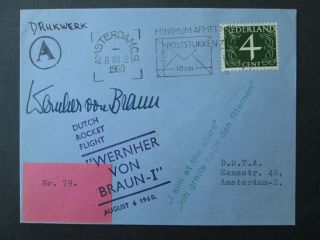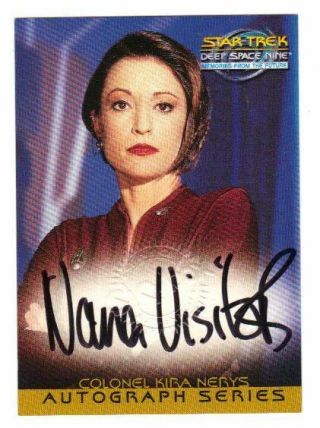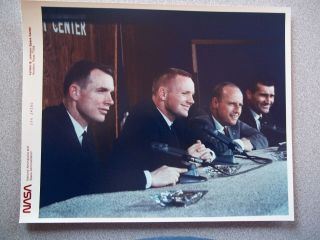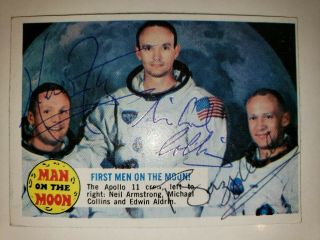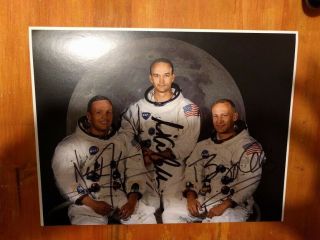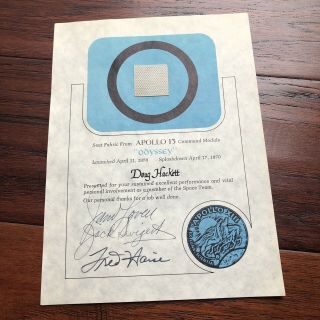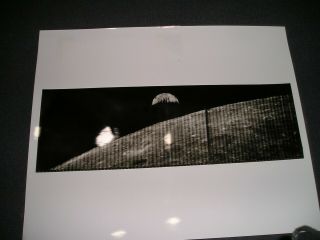HUGH HARRIS Hand Signed 4X6 Photo - VOICE OF SHUTTLE LAUNCH CONTROL - NASA - RARE
Item History & Price
| Reference Number: Avaluer:1627380 | Modified Item: No |
Hugh Harris’ NASA career lasted 34 years longer than he expected.Harris began working in NASA public affairs in February 1963 at the agency’s Lewis Research Center, later renamed Glenn Research Center. Previously, as a reporter, Harris covered Reaction Motors, a New Jersey company that manufactured the engine for the X-15 spaceplane. When he received simultaneous job offers from the U.S. Federal Reserve and NASA, Harris opted for space.“When I went to work at NASA, I was thinking along the lines of maybe working there for a year and then, having become an expert in everything, go back to the media and do stories for whoever I was working for, ” Harris said. “Within a relatively short period after I started working, I realized that what NASA was doing was probably one of the most important things being done in the country and for the world.”Harris’ NASA duties included handling press relations as well as preparing news releases and writing articles.At the time, Lewis Research Center efforts focused on propulsion and power generation as well as the Atlas-Centaur, Atlas-Agena and Thor-Agena rockets.The emphasis that Lewis placed on those particular rockets led to Harris’ first work in launch commentaries, which occurred in California at Vandenberg Air Force Base (VAFB).“It wasn’t very clear in those days as to who was responsible for what as far as public affairs was concerned, ” he noted. “Since we were responsible for a number of rockets that launch both at Kennedy Space Center (KSC) and at Vandenberg, and the KSC people didn’t go out to Vandenberg, I just started doing the commentary. So, I did dozens of rocket launches out there.”
Harris took the job.In 1975, Harris applied to be director of public affairs at KSC. He was edged out by Chuck Hollinshead, who in turn offered him the position of chief of public information at KSC.As the chief of public information, Harris oversaw KSC’s press site, an area next to the center’s Vehicle Assembly Building (VAB) where news media set up equipment and report launch progress.As part of Harris’ new job, he eventually would conduct launch commentary for a new era of American space missions: the Space Shuttle Program.Early Shuttles:April 1981 saw the first launch of the space shuttle.Columbia, the inaugural space-worthy shuttle orbiter, would rocket from KSC with a crew of two on an unprecedented test flight. For this first launch, Harris was the logical choice for launch commentary.“It’s not a too mysterious process, ” he said. “Since I had been doing unmanned launches and was in the position of the people who normally had done commentary on human space flight before that, it just sort of fell into my lap as something that naturally I would be doing.”To prepare for the launch, Harris attended dozens of practice countdowns conducted by the shuttle launch control team.“Of course, that was the best way to learn what was going to happen during the countdown.”Meanwhile, Harris and others in public affairs worked to better understand the workings of the space shuttle, also known as the Space Transportation System (STS).“We wrote dozens of fact sheets about all the major systems on the shuttle. In order to do that, we had to know something about it.”When Columbia lifted off, Harris’ words heralded the first moments of a 30-year program that took hundreds of humans into space.“We’ve gone for main engine start. We have main engine start. And we have liftoff. Liftoff of America’s first space shuttle! And the shuttle has cleared the tower, ” Harris said to audiences worldwide as Columbia soared to space for the first time.STS-1 landed successfully and safely in California.As the Shuttle program progressed with further missions, Harris thought it essential that more people became trained as launch commentators.“I immediately suggested to both people at KSC and at NASA headquarters that it was really dumb to have one person who was doing all of the human space flight, ” Harris said. “Having one person who could lose their voice or get sick or run over or whatever would happen didn’t make sense.“So, I finally got permission to have three people trained, including myself, to do commentary at any one time.”To learn how to conduct commentaries, trainees first would simply sit and observe launch commentaries. Then, they would take over commentary for early launch stages such as the fueling of the shuttles, he recalled.Fueling, also called tanking, “was a fairly benign period, and also it wasn’t being broadcast to the entire world.”Finally, the trainees would graduate to conducting full commentaries. Scripts were essential to a commentator’s success.“I really insisted on having a script that elaborated on what happened pretty much minute by minute, ” Harris added. “You’re listening to so many channels of information and you want to react to those, so it’s very easy to lose your way if you don’t have a roadmap.“I gave what I used to the people as they were trained, and they in turn gave that sort of thing to the people they were training eventually.”Harris and other commentators used a combination of video and audio feeds to assist their commentaries. The video feeds included both engineering camera views as well as public affairs camera shots of the shuttles. The public affairs views were made available for television broadcasts.“All of those feeds were available so that we could see what was happening and talk about it intelligently.”As Harris and other commentators covered the early era of shuttle launches, they were advised not to disrupt the developing coordination of the launch control team.“George Page was the launch director for the first launches, ” Harris said. “His orders to me were, ‘I don’t want you talking to anybody here in the control center.’ Also, he made us put up a Plexiglas shield so that the person at the next console to me hopefully would be shielded from my voice in his ear.“As a result, I had to develop a list of people who were familiar with each of the systems who were not in the control center and work with them prior to the launch so they knew there was a possibility I was going to call them.“Now, that relaxed a whole lot as the people in the firing room became more familiar with us and with launching. The first launch is always the trickiest one.”In 1986, plans were in place to begin shuttle flights from Vandenberg Air Force Base in California.These missions, reaching orbits not safely flyable from KSC, would have included Harris as a launch commentator, he confirmed.“I would have been at least one of the people doing the commentary.”However, the Space Shuttle Challenger disaster resulted in a permanent deviation from NASA’s shuttle plans. As a consequence, the Vandenberg shuttle missions never flew.Challenger:The Shuttle’s 25th flight was highly unlikely to launch on the morning it occurred.“As I went to the launch on that day, I was pretty convinced in my head that we were never going to launch, ” Harris noted.Liftoff was scheduled for the morning of January 28, 1986. Ice adorned KSC Launch Pad 39B, where Challenger stood poised for liftoff.Some people, including contractors at Rockwell, the builders of the shuttle orbiters, said the ice could fall from the pad during launch and gouge the orbiter’s thermal protection system, leaving her helpless against the extreme temperatures of atmospheric reentry.“Rockwell raised that as a red flag and said they were concerned with that, ” Harris remembered. “Then, they and people at Johnson Space Center (JSC) did a number of computer modeling exercises where they determined falling ice would not be a problem as far as the thermal protection system was concerned.”While the risk of falling ice was dismissed, another issue, this time with the shuttle solid rocket boosters (SRBs), also was analyzed.The cold could compromise the joints of the SRBs, allowing scorching gas to shoot from the boosters’ sides and onto the shuttle, said engineers at Morton-Thiokol, the company that built the boosters. This, too, was quietly dismissed by mission managers.“Nobody at Kennedy had heard about the concern that the Thiokol engineers had and the conferences that they had with the people at Marshall Space Flight Center, ” Harris recalled.“Everybody ended up saying to the launch director ‘we’re ready to go, ’ and the launch director, not knowing there was this back story there, felt that he really didn’t have an option.”Challenger’s right-hand SRB, crippled by the cold, would doom the mission.Harris, seated in the Launch Control Center, proceeded with his commentary as the launch countdown ticked to zero. Challenger rumbled to motion and shot off the pad.“Liftoff! Liftoff of the 25th space shuttle mission and it has cleared the tower, ” with Harris’ words now etched into history.With Challenger’s mission underway, control, as well as commentary for the mission shifted to JSC in Houston.Meanwhile, KSC’s launch control team watched the shuttle soar and prepared for post-launch activities. The vehicle arced skyward, billowing an ashen streak in her path. Challenger’s main engines throttled up to 104 percent of rated performance.A flame appeared on the right-hand SRB and grew to encompass the vehicle. The shuttle’s external tank, struck by the flame, ruptured and hemorrhaged fuel as the right SRB began to break free, throwing the shuttle into unsustainable aerodynamic stresses.Within seconds, Challenger flew into pieces and cascaded into the ocean, taking seven lives with her.Harris, along with the others in launch control, could only watch.“Once it launched and got up to the point where we had the vehicle consumed in flames, that came as a real shock to the people that I observed in the firing room where I was sitting. It was one of those things that you just really can’t quite comprehend, ” Harris said.“If everything was okay to launch, then how did this happen? There was a real shock through the entire room. It was very quiet. People pulled out their contingency plans and had to start on the process of safing the pad, notifying the other proper agencies and doing what they actually had trained to do.“I think people get through that, certainly in my case, because you know there are a lot of things that you’ve got to do and you don’t have time to be emotionally involved in what you’ve seen happen in front of your eyes.”While his primary concern was informing the public and maintaining transparency, Harris found that NASA’s immediate response to Challenger’s breakup was marred by disjointed priorities.While public affairs’ contingency plans mandated speedily making high-ranking NASA managers available to the media, those managers’ own plans prioritized other activities, such as reviewing flight imagery.“When everybody pulled out their plans and started looking at them, they were looking at what they had planned as opposed to what other people had planned on their behalf. So, it was a little bit ragged there.”Throughout the recovery and investigation following Challenger’s loss, Harris observed that some members of the media were in a frenzy to obtain the latest news, even if they risked publishing mere rumor, he said.In particular, news media sometimes wrote about recovery crews finding Challenger’s wrecked crew cabin in the waters of the Atlantic before the cabin actually had been found.“In some cases, I can remember a news person crying and saying they were likely to get fired because they didn’t have a story and I wasn’t giving it to them, ” Harris said. “I was saying, ‘I’m giving you the right information.'”Return to Flight:Rising from Challenger, NASA pressed onward to return to flight with the September 1988 launch of STS-26.NASA’s public affairs efforts improved in anticipation of the shuttle’s return.“What we tried to do was to make sure that the same mistakes weren’t made again if there was another accident, ” Harris added.One initiative was in direct response to a media complaint regarding film footage access in the Challenger aftermath.With Challenger, remote-controlled news media cameras from around the launch pad were impounded by NASA immediately after the mishap in the hopes that the film inside the cameras would yield clues as to exactly what went wrong. As a result, media were cut off from their own accident footage.For subsequent missions, NASA agreed to return cameras to news media as soon as safely possible, with the understanding that news media would share copies of their imagery with NASA.“Never again would you have an impounding of the press cameras and film and that sort of thing because a fear on the part of the technical people that information would be lost that would be vital to the investigation, ” Harris said.NASA also increased its educational outreach following the accident.When STS-26 Discovery lifted off and inaugurated the Shuttle program’s second chance, Harris felt cautiously confident that the mission would be successful.“I had great faith in all of the things that had been done. I had known how hard everyone had worked on trying to ensure that there was never another Challenger, knowing still that when you have that many systems and how complex they are, there’s always a chance something can go wrong.“Even though you’ve tested something a lot of times, one of the problems is that if you test it too much, it’s probably gonna break. There has to be a balance between testing it just enough and not wearing out whatever system you’re testing.”The run-up to STS-26 saw Harris’ promotion from chief of public information to deputy director of public affairs at KSC.While this promotion technically put commentary out of Harris’ job description, NASA managers stipulated that he proceed with commentary for STS-26 regardless.“Theoretically, whoever was the chief of public information at that time and the other people who had been trained to be commentators would normally do that, ” Harris noted. “However, the Director Chuck Hollinshead and the assistant administrator for public affairs at Headquarters said, ‘no, you are the one who’s going to do that.’ And, of course, I was happy to do it.“It was very comfortable doing commentary and I really wanted to be part of that launch, so I was very pleased. But, I would not have done it had I not been told that I should.”The success of STS-26 would determine the Shuttle program’s survival.“If we had a second disaster at that point, I think the whole program would have been canceled, ” he noted. “We never would have built the International Space Station, serviced the Hubble Telescope and all the other things we did.”NASA’s efforts succeeded.When STS-26 Discovery roared skyward, she and her crew made it safely to orbit. From launch control, Harris observed a reassured launch team.“There was a tremendous sigh of relief when the solid motors separated and it continued to climb into orbit, ” Harris recalled.“There certainly were some muted cheers and everybody really relaxing a little bit more than they had before. Of course, once it gets off the pad, the people in the launch control center don’t have much they can do to change things.”Director of Public Affairs and Onward:By the 1990s, Harris had fully transferred commentary duties to his successors. In 1992, Chuck Hollinshead retired, and Harris took over as KSC’s director of public affairs.“It’s always a lot of fun to actually be able to influence events more than you can when you’re at a lower level.”During his tenure, Harris oversaw radical improvements to KSC’s visitor facilities.One such improvement was the multi-million dollar construction of KSC’s Saturn V Center, a building housing one of the three remaining Saturn V rockets along with other Apollo-era artifacts.The Saturn V placed in the center had for years been exposed to the elements and needed restoration work to be readied for display.“The Saturn V Center was something that involved a tremendous amount of time in the design and in very small details that I actually never would have expected to get involved in.Harris sought to establish a sense of unity across all of KSC’s public interactions.“Looking at the educational activities in conjunction with what you talked about to the press and then what you talked about to the public through the visitor activities, it was very satisfying to be able to help have a cohesive message.”In addition, Harris created a volunteer program at KSC that allowed retirees to return to the center and continue to shape its direction.Harris retired in 1998 after 35 years with NASA. He continues to work in the same KSC volunteer program that he established.KSC’s written public affairs content increasingly is generated by contractors, but the center will continue sharing a steady output of new discoveries and activities with the public.In addition to his volunteer duties, Harris continues to write about NASA.In 2014, he released “Challenger: An American Tragedy, ” an e-book covering the Challenger disaster while focusing on the people involved in the accident and its aftermath.“I felt that, at the time I was writing it, that this was long after it had been exhaustively investigated and covered by the media, and there were a number of books already on the subject, ” Harris added. “I felt that the main contribution I could make was trying to have it be as much about people as possible. Because, in the long run, that’s what the space program is about.“It’s really about the people here on Earth, and the people in the program who accomplish all of these things don’t really get the credit or the understanding that they deserve.”Harris is writing several more books that will profile the people who made NASA’s reach into space possible.For his own contributions, Harris said that he was a privileged participant.“I was fortunate to be associated with KSC and NASA at one of the most interesting eras of civilization.What I was privileged to be able to see were things that have changed the world we live in and, in many cases, for the better.”




